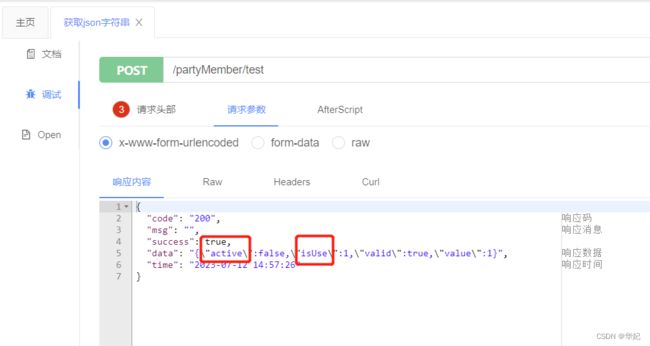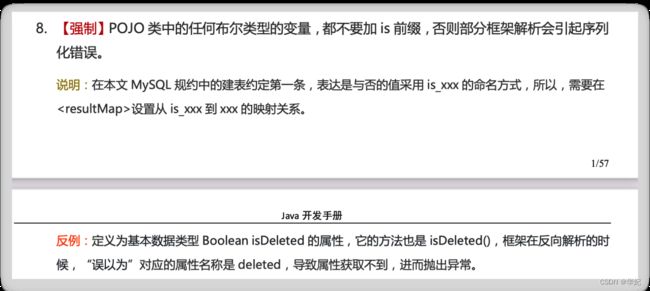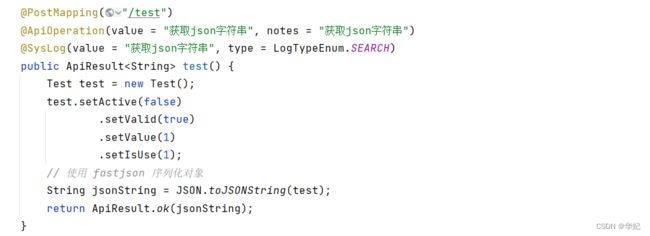使用fastjson序列化后字段属性发生了变化
问题描述
使用 fastjson 进行 JSON 序列化存储到数据库后,发现 JSON 字符串“莫名其妙地”多了一些属性,也少了些属性。问题出现在基本类型的布尔类型以 is 开头的属性。
复现
1、定义对象
其中一个boolean类型的属性isActive以is开头,一个Integer 类型的属性isUse以is开头。
@Data
@Accessors(chain = true)
public class Test {
private boolean isActive;
private Integer isUse;
private boolean valid;
private Integer value;
}
2、使用fastjson序列化
3、测试结果
发现少了isActive没有正常返回,isUse正常返回了。

问题分析
通过调试可以发现,问题出现在下面这个函数:
com.alibaba.fastjson.serializer.SerializeConfig#createJavaBeanSerializer(java.lang.Class<?>)
publicfinal ObjectSerializer createJavaBeanSerializer(Class<?> clazz) {
String className = clazz.getName();
long hashCode64 = TypeUtils.fnv1a_64(className);
if (Arrays.binarySearch(denyClasses, hashCode64) >= 0) {
throw new JSONException("not support class : " + className);
}
// 关键
SerializeBeanInfo beanInfo = TypeUtils.buildBeanInfo(clazz, null, propertyNamingStrategy, fieldBased);
if (beanInfo.fields.length == 0 && Iterable.class.isAssignableFrom(clazz)) {
return MiscCodec.instance;
}
return createJavaBeanSerializer(beanInfo);
}
而 buildBeanInfo 的关键是com.alibaba.fastjson.util.TypeUtils#computeGetters
public static List<FieldInfo> computeGetters(Class<?> clazz, //
JSONType jsonType, //
Map<String,String> aliasMap, //
Map<String,Field> fieldCacheMap, //
boolean sorted, //
PropertyNamingStrategy propertyNamingStrategy //
){
// 省略部分代码
if(methodName.startsWith("is")){
if(methodName.length() < 3){
continue;
}
if(returnType != Boolean.TYPE
&& returnType != Boolean.class){
continue;
}
char c2 = methodName.charAt(2);
String propertyName;
Field field = null;
if(Character.isUpperCase(c2)){
if(compatibleWithJavaBean){
propertyName = decapitalize(methodName.substring(2));
} else{
propertyName = Character.toLowerCase(methodName.charAt(2)) + methodName.substring(3);
}
// 这里 isActive 的属性名被计算出 active
propertyName = getPropertyNameByCompatibleFieldName(fieldCacheMap, methodName, propertyName, 2);
}
// 省略其他
JSONField fieldAnnotation = null;
if(field != null){
fieldAnnotation = TypeUtils.getAnnotation(field, JSONField.class);
if(fieldAnnotation != null){
if(!fieldAnnotation.serialize()){
continue;
}
ordinal = fieldAnnotation.ordinal();
serialzeFeatures = SerializerFeature.of(fieldAnnotation.serialzeFeatures());
parserFeatures = Feature.of(fieldAnnotation.parseFeatures());
if(fieldAnnotation.name().length() != 0){
//关键:使用 JSONField 注解设置的 name 替代属性名
propertyName = fieldAnnotation.name();
if(aliasMap != null){
propertyName = aliasMap.get(propertyName);
if(propertyName == null){
continue;
}
}
}
if(fieldAnnotation.label().length() != 0){
label = fieldAnnotation.label();
}
}
}
// 省略部分代码
FieldInfo fieldInfo = new FieldInfo(propertyName, method, field, clazz, null, ordinal, serialzeFeatures, parserFeatures,
annotation, fieldAnnotation, label);
fieldInfoMap.put(propertyName, fieldInfo);
}
}
Field[] fields = clazz.getFields();
computeFields(clazz, aliasMap, propertyNamingStrategy, fieldInfoMap, fields);
return getFieldInfos(clazz, sorted, fieldInfoMap);
}
其实 fastjson 通过反射虽然有能力识别真实的属性名,但是实际操作时会根据 getter 方法反推出属性名,造成转为 JSON 字符串时和实际属性名存在偏差。
解决办法
1、遵循阿里巴巴 Java 开发手册
《Java 开发手册》 中专门强调任何布尔类型的变量都不要加 is 前缀,基本类型布尔属性反向解析时,会误以为不带 is 导致获取不到属性,抛出异常。

2、使用别名
使用 fastjson 自带的 @JSONField 注解,不过这种方式 fastjson 的侵入性太强。

3、使用hutool的JSONUtil.toJsonStr()
